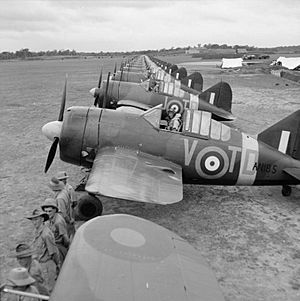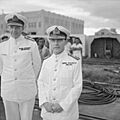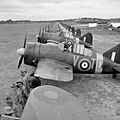Tom Phillips (Royal Navy officer) facts for kids
Quick facts for kids
Tom Spencer Vaughan Phillips
|
|
|---|---|
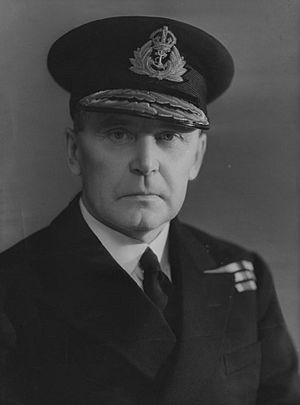
Vice Admiral Tom Phillips in March 1940
|
|
| Birth name | Tom Spencer Vaughan Phillips |
| Nickname(s) | Tom Thumb |
| Born | 19 February 1888 Pendennis Castle, Falmouth, Cornwall |
| Died | 10 December 1941 (aged 53) South China Sea, off Kuantan, Malaya |
| Allegiance | United Kingdom |
| Service/ |
Royal Navy |
| Years of service | 1903–1941 |
| Rank | Admiral |
| Commands held | Force Z (1941) Eastern Fleet (1941) China Station (1941) Home Fleet Destroyer Flotillas (1938–39) HMS Hawkins (1932–35) 6th Destroyer Flotilla (1928–29) HMS Campbell (1928–29) HMS Verbena (1924–25) |
| Battles/wars | |
| Awards | Knight Commander of the Order of the Bath |
Admiral Sir Tom Spencer Vaughan Phillips (born February 19, 1888 – died December 10, 1941) was a brave officer in the Royal Navy. He served during both the First and Second World Wars. People called him "Tom Thumb" because he was shorter than average.
He is most famous for leading a group of ships called Force Z. This happened during the Japanese invasion of Malaya in World War II. Admiral Phillips died when his main ship, the battleship HMS Prince of Wales, was sunk. He was one of the highest-ranking Allied officers to be killed in battle during the Second World War.
Contents
Early Life and Nickname
Tom Phillips was born on February 19, 1888. His father was Colonel Thomas Vaughan Wynn Phillips. His mother was Louisa Mary Adeline de Horsey Phillips. Her father was also an Admiral.
Phillips was about 5 feet 4 inches (162 cm) tall. When he died at age 53, he was one of the youngest admirals in the Royal Navy. He was also one of the youngest commanders in charge of a fleet.
Phillips joined the Royal Navy in 1903. He started as a naval cadet after going to Stubbington House School. In 1904, he became a midshipman and trained on HMS Britannia.
He was promoted to sub-lieutenant in 1908. Then, in 1909, he became a lieutenant.
World War I Service
During the First World War, Phillips served on destroyers. These ships were in the Mediterranean Sea and the Far East. He was promoted to lieutenant commander in 1916.
After the war, he studied at the Royal Navy Staff College. From 1920 to 1922, he advised the League of Nations on military matters.
Rising Through the Ranks
Phillips continued to rise in rank. He became a commander in 1921. In 1927, he was promoted to captain. He commanded the destroyer HMS Campbell from 1928 to 1929.
From 1930 to 1932, Phillips worked at the British Admiralty, which was like the Navy's headquarters. He helped plan naval operations. He then spent three years in the Far East.
In 1935, he returned to the Admiralty to lead the Plans Division. In 1938, he became a commodore. He commanded the destroyer fleets of the Home Fleet.
In 1939, Phillips became a rear admiral. He also served as an aide-de-camp to King George VI. From 1939 to 1941, he was a very important leader at the Admiralty. He was the Deputy Chief and then Vice Chief of the Naval Staff.
Phillips earned the trust of Prime Minister Winston Churchill. Churchill made him an acting vice admiral in 1940.
Force Z and the Battle of Malaya
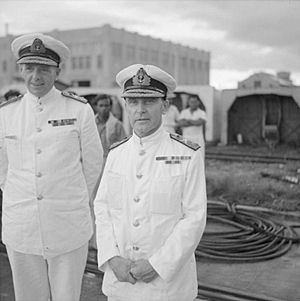
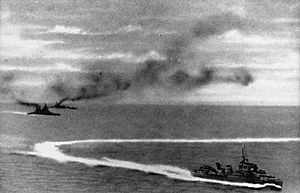
In late 1941, Phillips was put in charge of the China Station. This was a big naval command. He became an acting admiral. On October 25, 1941, he sailed to his headquarters in Singapore.
He traveled with a group of ships called Force G. This group included his flagship, the new battleship HMS Prince of Wales. It also had the older battlecruiser HMS Repulse and four destroyers.
Prime Minister Winston Churchill decided to send these ships. Some naval leaders, like Admiral of the Fleet Sir Dudley Pound, warned against it. They worried about the ships being attacked from the air.
A new aircraft carrier called HMS Indomitable was supposed to join them. But it ran aground on its first trip and couldn't go.
Phillips and his ships arrived in Singapore on December 2, 1941. There, they were renamed Force Z.
The Japanese Attack
On December 8, 1941, Japan attacked Malaya. This was the same day as the attack on Pearl Harbor. The Japanese attacked in several places at once. They hoped to keep the Royal Air Force busy. This would leave Phillips' ships without air cover.
Phillips believed that aircraft were not a big threat to warships. So, he took Force Z to stop the Japanese without air cover. This decision has been debated ever since. Force Z left Singapore on December 8.
Phillips hoped to stop more Japanese troops from landing. He sent a message to his fleet: "We are out looking for trouble, and no doubt we shall find it."
Soon after, Phillips learned that the Royal Air Force was too busy fighting on land. They could not provide air cover for his ships. Japanese bombers were already in the area.
Force Z sailed north. On December 9, a Japanese submarine spotted Phillips' ships. The submarine tried to follow, but the ships disappeared in a sudden storm.
Later that day, Phillips saw Japanese planes. He realized his ships were in danger. He decided to turn back to Singapore. But then he heard about a Japanese landing at Kuantan. He decided to attack there.
The Sinking of the Ships
On December 10, Phillips sent a destroyer to check Kuantan harbor. It was empty. Phillips did not know that his information was wrong. He kept searching for an enemy that wasn't there.
Ten Brewster Buffalo fighter planes were assigned to protect Force Z. But Phillips decided not to ask for air support. He thought it was more important to keep radio silence.
Around 10:20 AM on December 10, a Japanese plane was seen watching HMS Prince of Wales. The ship's crew got ready for an attack.
At 11:00 AM, nine Japanese planes attacked HMS Repulse. A bomb hit the ship, causing a fire.
At 11:15 AM, Captain William Tennant of Repulse radioed for help. At 11:40 AM, HMS Prince of Wales was attacked by planes carrying torpedoes. It was hit at the back, damaging its propellers and steering.
More torpedo planes attacked Repulse. A reporter named Cecil Brown was on board. He described the attack:
One plane is circling around. It's now at 300 or 400 yards, approaching us from the port side. It's coming closer head-on, and I see a torpedo drop. A watcher shouts, "Stand by for torpedo", and the tin fish is streaking directly for us.
Some one says: "This one's got us."
The torpedo struck the side on which I was standing... It felt like the ship had crashed into a well-rooted dock. It threw me four feet across the deck...
Almost immediately... we began to list, and less than a minute later there was another jar...
The communications system announced: "Prepare to abandon ship. May God be with you."
Both HMS Prince of Wales and HMS Repulse were sunk by Japanese air attacks. This happened on December 10, 1941. Eighty-six Japanese bombers and torpedo planes attacked them.
Destroyers rescued 2,081 sailors from the two ships. But 840 sailors were lost. Captain John Leach of Prince of Wales and Admiral Phillips went down with their ship. As the British warships sank, the Australian planes finally arrived.
After the Sinking
After the British fleet was destroyed, the Japanese continued to advance in Malaya. The British Army had to retreat to Singapore. On February 15, 1942, British Lieutenant General Arthur Percival surrendered his army to the Japanese. This was a huge surrender in British history.
Naval historian Samuel Eliot Morison wrote about Phillips' decision to go without air cover. He said that military leaders always weigh risks against gains. Phillips decided to take a chance. He hoped to stop the enemy, and the Royal Navy wanted to fight.
Morison also wrote that the sinking of the ships taught a lesson. It seemed to show that large warships could not stand up to land-based air power. This made the Allies lose confidence in themselves in the Pacific.
Admiral Thomas Hart, Phillips' American counterpart, was critical of the lack of air support. He said, "The only thing that would have saved Singapore would have been the success of Admiral Sir Tom Phillips' attempt to place his heavy ships where they could sink the Japanese transports at sea. We have never heard why the R.A.F. fighters, which were half an hour away, gave Admiral Phillips no help whatever."
Admiral Phillips' name is remembered at the Plymouth Naval Memorial in Plymouth, England.
Images for kids


